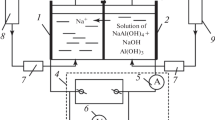Abstract
Six experiments are presented to highlight important features of aluminium dissolution when used in electrocoagulation procedure employed to remove oily contaminations from water. First, using a common oil-in-water emulsion: diluted milk, we show that the electrochemically generated coagulant ions are active only in the first few seconds following their generation—hence, the electrocoagulation cells’ construction should promote the mixing of the nascent Al colloid with the water phase. For this reason, the use of the narrow-gap cells is suggested. Second, in experiments with Al-Al electrode pairs and dilute, neutral, unbuffered, aqueous solutions we (i) estimate the maximum amount of Al dissolution on the cathode and (ii) show how the rate of Al dissolution changes with frequency if the cell voltage polarity is alternating.






Similar content being viewed by others
References
Everett DH (1988) Basic principles of colloid science. The Royal Society of Chemistry, London, p. ch.9
Abrantes LM (2012) In: Bard AJ, Inzelt G, Scholz F (eds) Electrochemical Dictionary, 2nd edn. Springer, Heidelberg, p. 294
Mollah MYA, Schennach R, Parga JR, Cocke DL (2001) Electrocoagulation (EC)—science and applications. J Hazard Mater 84:29–41
Vepsäläinen M (2012) Electrocoagulation in the treatment of industrial waters and wastewaters. Thesis, VTT Technical Research Centre of Finland, Espoo, Finland
Sahu O, Mazumdar B, Chaudhari PK (2014) Treatment of wastewater by electrocoagulation: a review. Environ Sci Pollut Res Int 21:2397–2413
Emamjomeh MM, Sivakumar M (2009) Review of pollutants removed by electrocoagulation and electrocoagulation/flotation processes. J Environ Manag 90:1663–1679
Duana J, Gregory J (2003) Coagulation by hydrolysing metal salts. Adv Colloid Interf Sci 100–102:475–502
Canizares P, Martinez F, Jimenez C, Saez C, Rodrigo MA (2008) Coagulation and electrocoagulation of oil-in-water emulsions. J Hazard Mater 151:44–51
Water quality – Determination of the chemical oxygen demand, ISO-6060: 1989
Bensadok K, Benammar S, Lapicque F, Nezzal G (2008) Electrocoagulation of cutting oil emulsions using aluminium plate electrodes. J Hazard Mater 152:423–430
Black AP, Buswell AM, Eidsness FA, Black AL (1957) Review of the Jar Test, Journal (American Water Works Association) 49: 1414, stable URL: http://www.jstor.org/stable/41254753
Pajkossy T, Fekete É, Cserfalvi T, Lengyel B (2016) Electrocoagulation: an electrochemical process for water clarification. J Electrochem Sci Technol. doi:10.5599/jese.218
Khemis M, Leclerc JP, Tanguy G, Valentin G, Lapicque F (2006) Treatment of industrial liquid wastes by electrocoagulation: experimental investigations and an overall interpretation model. Chem Eng Sci 61:3602–3609
Khemis M, Tanguy G, Leclerc JP, Valentin G, Lapicque F (2005) Electrocoagulation for the treatment of oil suspensions: relation between the rates of electrode reactions and the efficiency of waste removal. Process Saf Environ Prot 83(B1):50–57
Attour A, Touati M, Tlili M, Ben Amor M, Lapicque F, Leclerc JP (2014) Influence of operating parameters on phosphate removal from water by electrocoagulation using aluminum electrodes. Sep Purif Technol 123:124–129
Caldwell BP, Albano VJ (1939) Rate of solution of zinc and aluminum while cathodic. Trans Electrochem Soc 76:271–285. doi:10.1149/1.3500282
van de Ven EPGT, Koelmans H (1976) The cathodic corrosion of aluminum. J Electrochem Soc 123:143–144
Despić AR, Radošević J, Dabić P, Kliškić M (1990) Abnormal yields of hydrogen and the mechanism of its evolution during cathodic polarization of aluminum. Electrochim Acta 35:1743–1746
Moon SM, Sl P (1997) The corrosion of pure aluminium during cathodic polarization in aqueous solutions. Corros Sci 39:399–408
Picard T, Cathalifaud-Feuillade G, Mazet M, Vandensteendam C (2000) Cathodic dissolution in the electrocoagulation process using aluminium electrodes. J Environ Monit 2:77–80
Mouedhen G, Feki M, Wery MDP, Ayedi HF (2007) Behavior of aluminum electrodes in electrocoagulation process. J Hazard Mater 150:124–135
Mechelhoff M, Kelsall GH, Graham NJG (2013) Super-faradaic charge yields for aluminium in neutral aqueous solutions. Chem Eng Sci 95:353–359
Canizares P, Carmona M, Lobato J, Martınez F, Rodrigo MA (2005) Electrodissolution of aluminum electrodes in electrocoagulation processes. Ind Eng Chem Res 44:4178–4185
Uhlig HH (1963) Corrosion handbook. Wiley, New York, p. 54
Acknowledgments
Financial support of the National Research, Technology and Innovation Office of the Hungarian government through projects KMR_12-1-2012-0386 and OTKA-K-112034 is acknowledged.
Author information
Authors and Affiliations
Corresponding author
Rights and permissions
About this article
Cite this article
Fekete, É., Lengyel, B., Cserfalvi, T. et al. Electrochemical dissolution of aluminium in electrocoagulation experiments. J Solid State Electrochem 20, 3107–3114 (2016). https://doi.org/10.1007/s10008-016-3195-6
Received:
Revised:
Accepted:
Published:
Issue Date:
DOI: https://doi.org/10.1007/s10008-016-3195-6




